
A “Neck” painting by artist Christian de Laubadère embraces Chinese imagery and European tradition. Born in France and now living in Shanghai, Christian represents the increasing international collaboration within the Chinese art world.
HONG MERCHANT ANTIQUES GALLERY OPENING
When two friends, Shanghai-based venture capitalist Laurette Hartigan and Santa Barbara-based author Beverly Johnson (who collects Chinese antiques), both suggested I go to an opening at Hong Merchant, a Chinese and French-influenced antiques and art gallery, I knew it was a must.
I had enjoyed the inviting atmosphere at Hong Merchant previously, when friends bought some antiquities there. When they later had the items appraised at home in the U.S., the gallery turned out to be spot-on regarding authenticity and pricing.
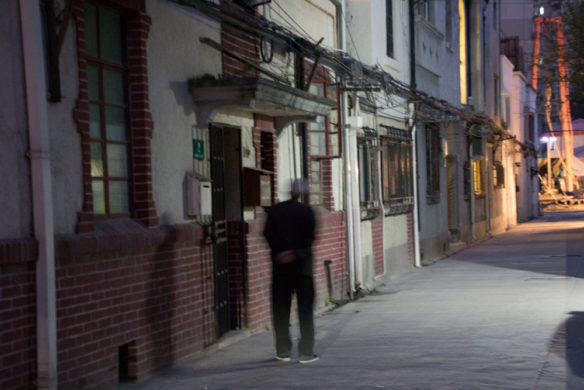
Hong Merchant Gallery is located on one of Shanghai’s fascinating lane streets, where you often have the sense of discovering a secret place.
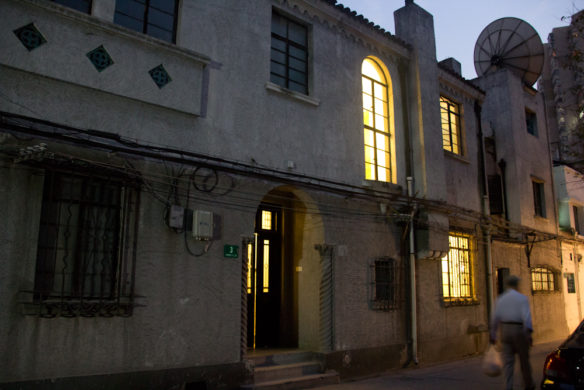
When I first arrived in Shanghai, I had to learn the city’s unique address system. For the gallery, one must go to the main street, Xing Guo Road, then find Lane 372, and then look for House No. 3.
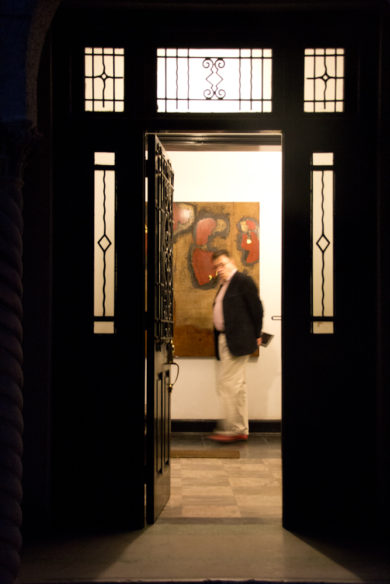
Converted into a gallery, this historical 1930s-era French Concession villa, called a longtang, or lane house, has been lovingly but not excessively restored, with the original wooden floors and lead glass windows, plus exposed brick walls and a small garden on the ground floor.
THE ARCHAEOLOGIST COLLECTOR
I was greeted by one of the former partners, French-born Anne-Cécile Noïque, now an independent art consultant. She is opening a new space to show contemporary Chinese artists and foreign artists-in-residence in China—another item on the must-see list for my next visit to Shanghai.
Anne-Cecile introduced me to Pia Pierre, the Danish gallery founder. A renowned archaeologist and art historian specializing in Southeast Asian antiquities, Pia lives in Thailand and Shanghai, and travels widely in China.
In the 30 years Pia has been collecting wares, Hong Merchant has become well known for its carefully selected antique Chinese furniture and decorative pieces, which are displayed alongside China-inspired contemporary art.
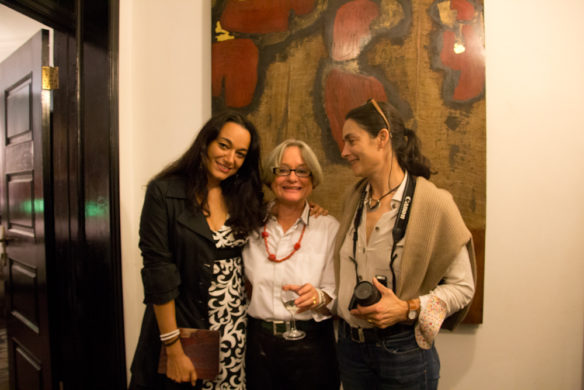
Anne-Cécile Noïque, Pia Pierre, and Lou Koura.
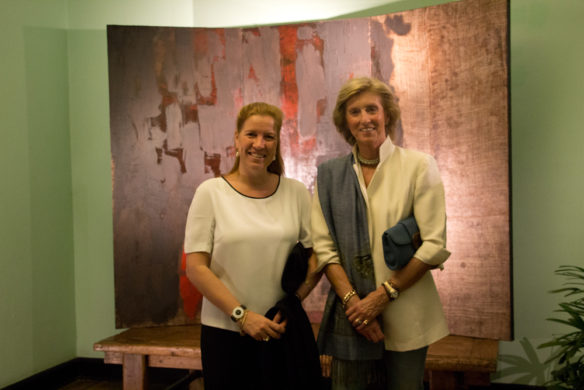
Shanghai-based fashion designer Fleur Loudon (right) and friend.
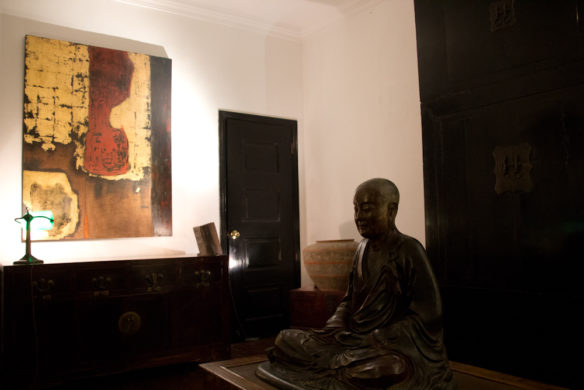
A mix of contemporary artwork and antiques are displayed throughout the villa, which offers a far more intimate viewing experience than the usual commercial gallery.
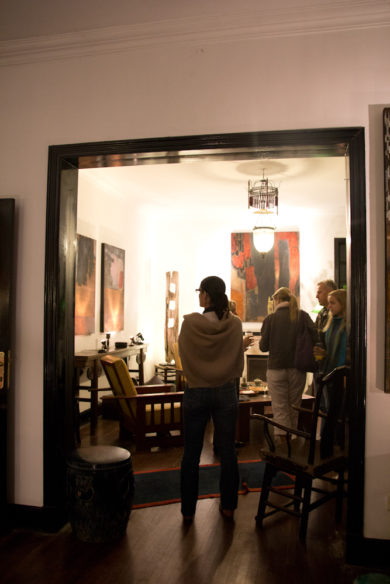
By observing art in this setting, collectors can visualize how the paintings and antiques will look in their own homes.
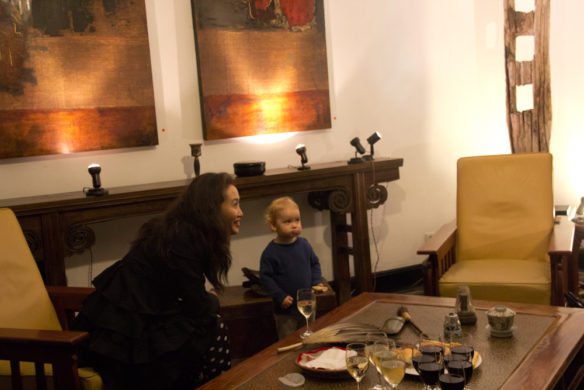
It’s never too early to start cultivating an appreciation of fine art.

Another young art lover. Many visitors, especially the French, arrived with their children in tow.

Invitees feel comfortable in this gallery, once a private home.
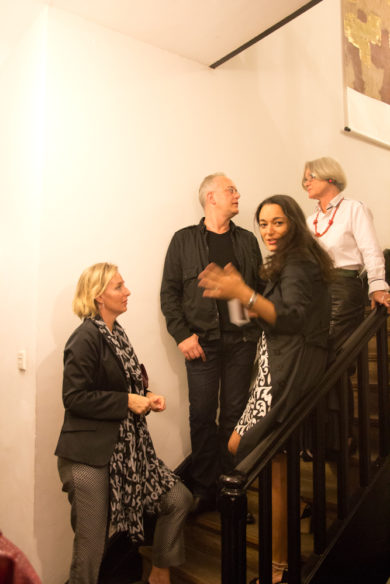
Anne-Cécile Noïque and gallery founder Pia Pierre chat with guests.
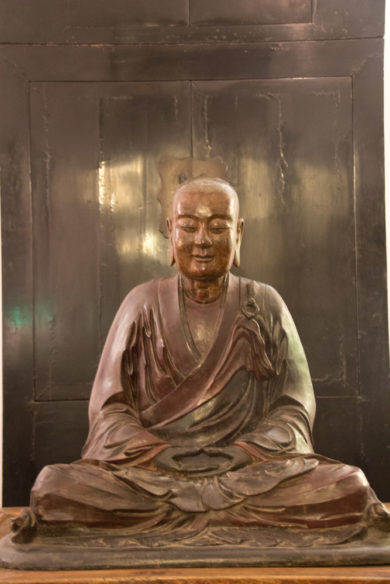
Everything on display in this house-museum is for sale, including exceptional Ming and Qing Dynasty pieces, Chinese sculpture, furniture, and decorative objects.
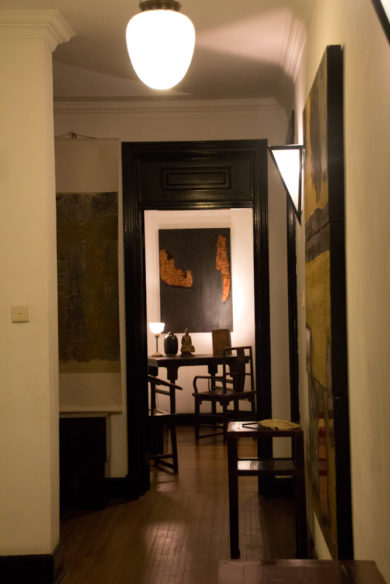
Meandering through the two-story building, visitors find art in every nook and cranny, gaining a sense of how life in old Shanghai was once lived.
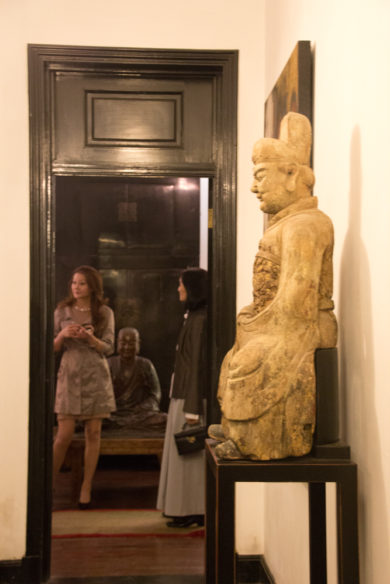
Elegant statues and contemporary works of art create a stunning environment and recall the house’s past glory.
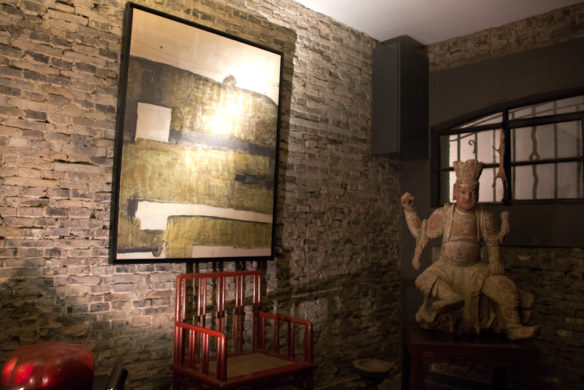
Downstairs, at the back of the house, I found a small room with exposed brick walls laden with red lacquers, pottery, and wood antiques.
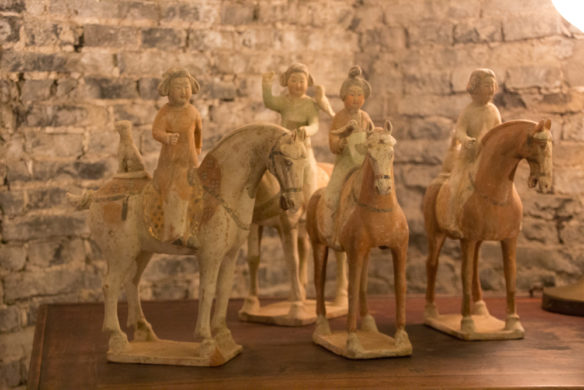
Tang Dynasty figurines decorated the private meditative space.
ARTIST WENSEN QI
Hong Merchant Gallery’s specialty is the mingling of European and Asian art. Painter Wensen Qi, a native of Toulouse, is one of many French artists whose work it shows.
Born Vincent Cazeneuve, he was dubbed Wensen (a phonetic translation of his French name) by his Chinese lacquer master, and he’s gone by this name since establishing his workshop in Chongqing. Qi is the Chinese character for “lacquer.”
Wensen originally studied and mastered wood cabinet making, marquetry, and gilding. Fascinated by lacquer, he opened his own atelier specializing in restoration of Asian and Western lacquer ware.
Since the 1990s, the artist has specialized in lacquer painting, an ancient art of China and Japan that has been practiced for thousands of years.
An abstract artist, Wensen incorporates many natural materials into his paintings, among them mud, linen, silver, gold, tin, lead, shells, stone, and wood. These create different textures and give a tactile quality to his paintings.
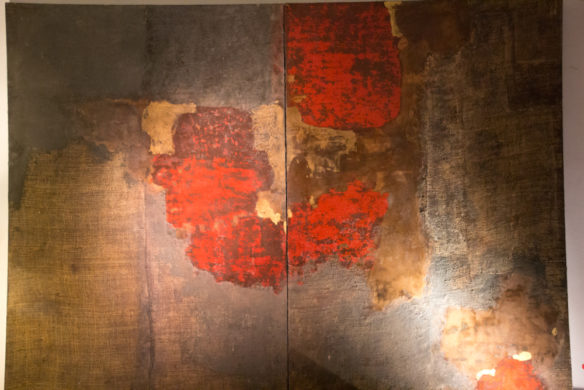


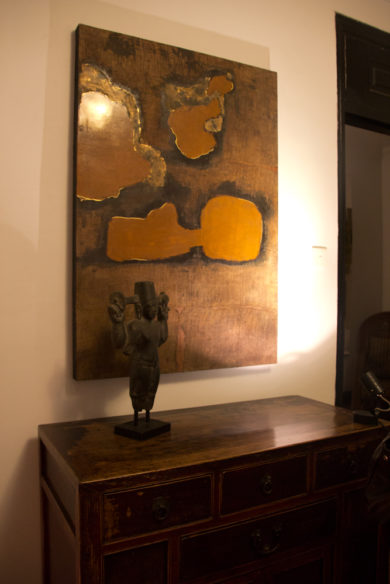
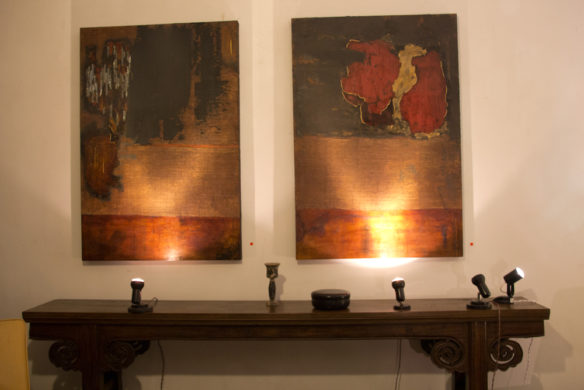
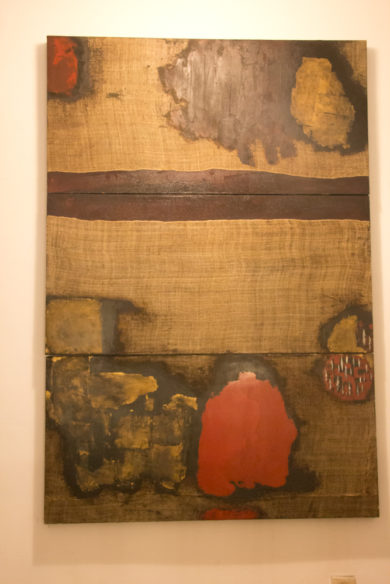
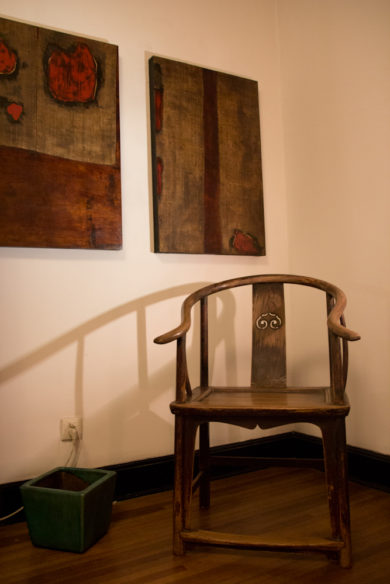
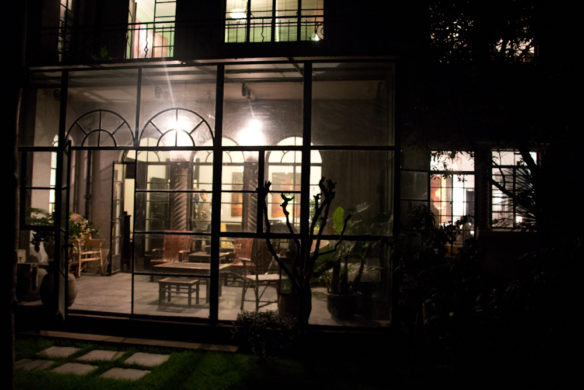
HONG MERCHANT BY DAY
Anne-Cécile invited me back to Hong Merchant Gallery for coffee the next morning. By daylight, the wonderful garden and the details of the shop and the objects were even more enjoyable.



CHRISTIAN DE LAUBADERE LOFT STUDIO
After coffee, we grabbed a cab and headed to the atelier of artist Christian de Laubadère, a native of the Gascony region of southwest France who has lived and worked in Shanghai since 2001.
Minutes later, we were knocking on the door to his studio, a loft-like space designed by the artist himself. This is what’s special about Shanghai—there is always another surprise.
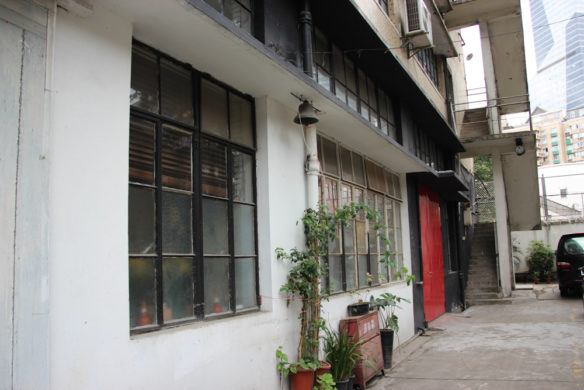
The artist lives and works in this building in an old Shanghai neighborhood.

Anne-Cécile Noïque knocks on the door to Christian’s studio.

Christian designed and decorated his loft-like studio himself. You can see a documentary about him at http://vimeo.com/31429526.
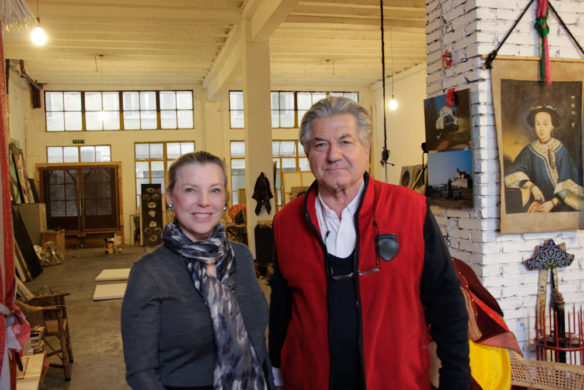
Jeanne Lawrence and artist Christian de Laubadère.
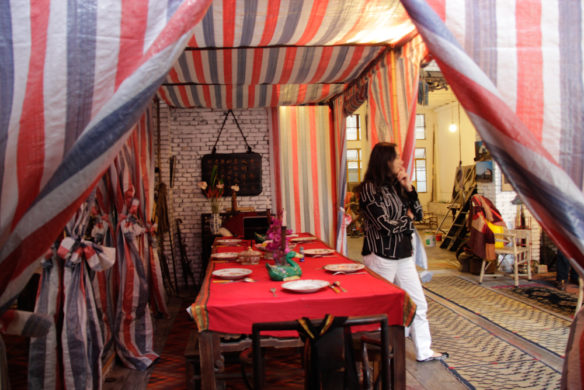
The unique space has intimate areas for dining and a second-story bedroom.
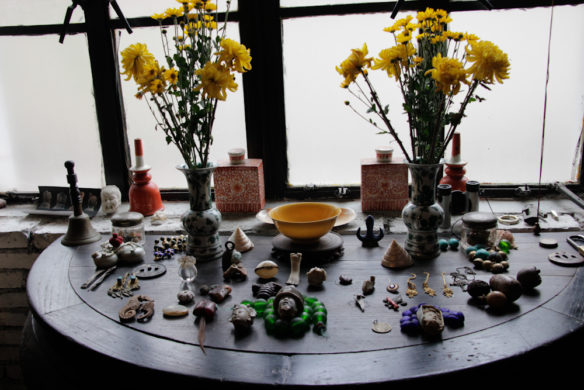
With an artist’s eye, Christian has organized collections of objects into still-life arrangements.
DE LAUBADERE’S “NECKS” SERIES
We viewed pieces from Christian’s “Necks” series. These exquisite paintings depict the back of women’s heads, their hair arranged into intricate, traditional Chinese hairstyles, jewelry in their coifs or fastened at their ears, and rich fabrics draped at their shoulders.
Christian considers the neck (in particular the nape) and hands to be the most beautiful parts of the female body. A combination of French and Chinese styles, Christian’s distinctive work is immediately recognizable.
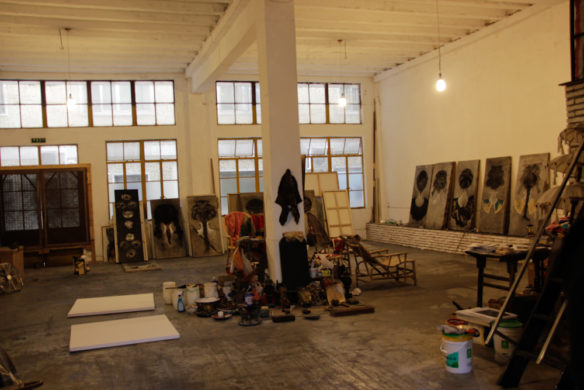
In Christian’s studio, “Neck” paintings are in various stages of progress.

The atelier is filled with a wide array of tools and materials.
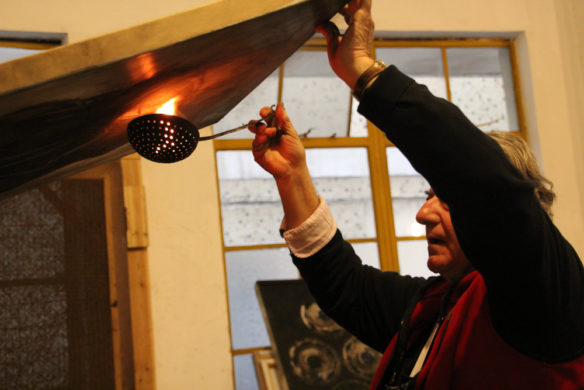
The artist illustrates how he “antiques” his canvases with smoke, then draws on them with lead pencils, charcoal, and paint.

He uses a “comb brush” to create the sweeping, graphic look of the intricate hairstyles.
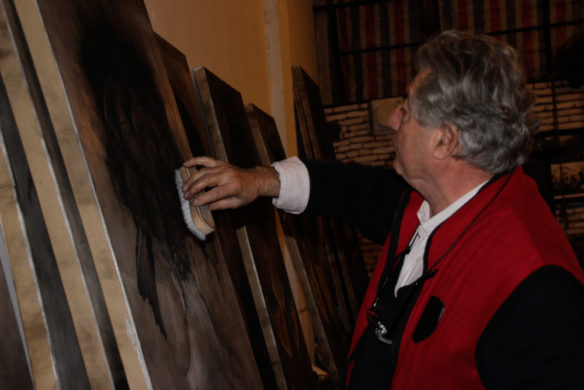
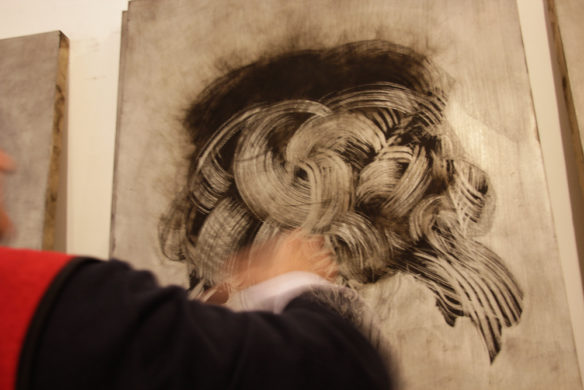
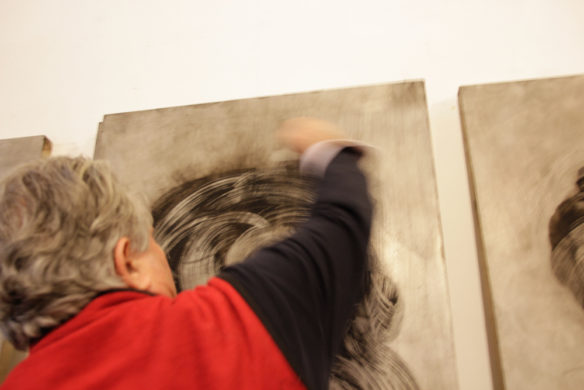
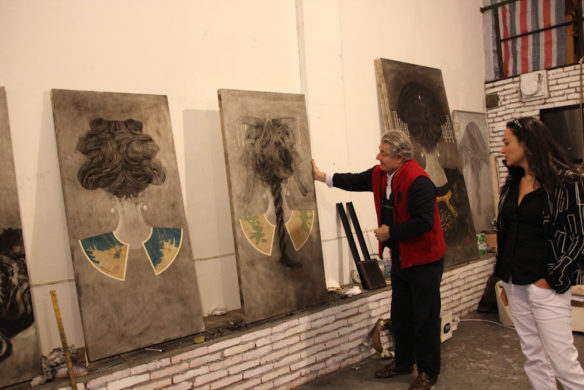
In his works, the artist uses antique fabric or printed paper from China and France to create the shoulders of the dresses his subjects wear.
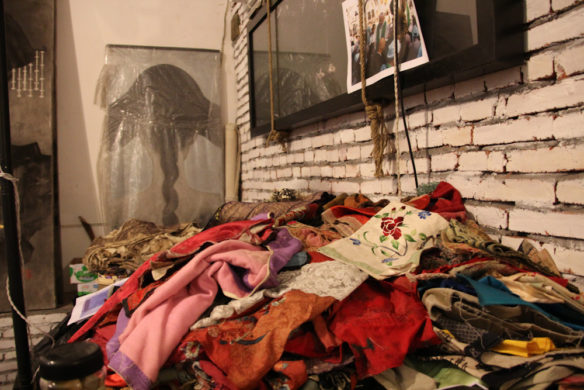
Christian’s vast collection of antique fabric scraps.
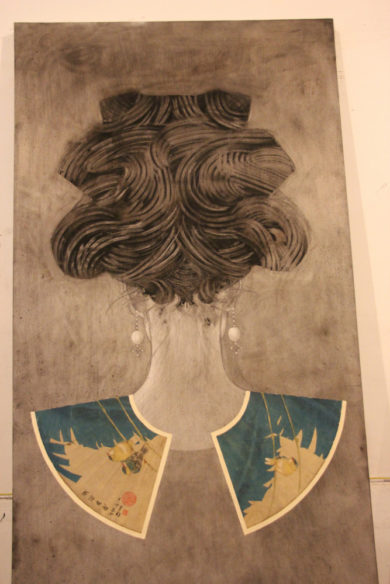
The mysterious, sensuous images evoke a bygone era.
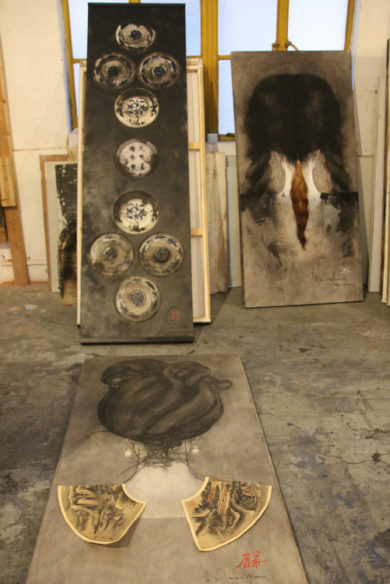
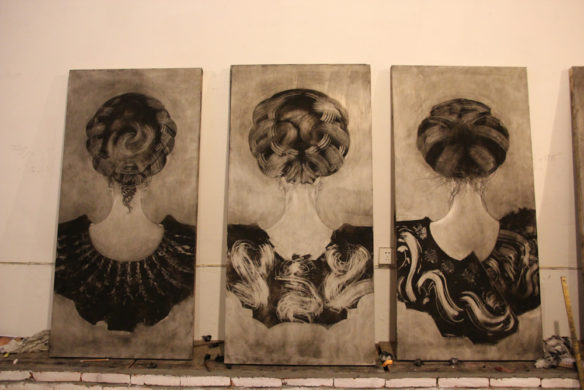
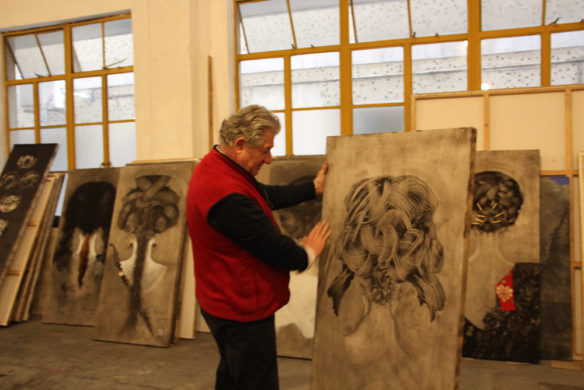


On his iPad, Christian showed us the new St. Regis Resort, which commissioned original works of art from local and international artists.
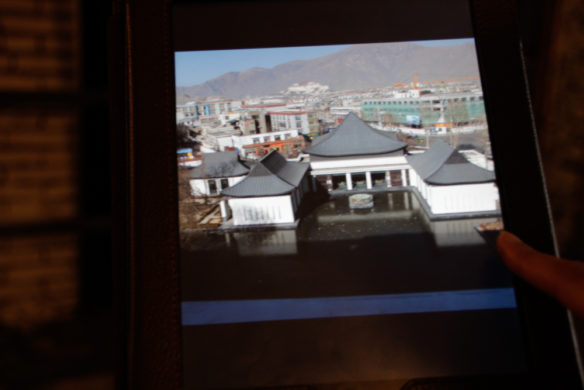
Prominent in the St. Regis lobby is Christian’s six-panel painting, each one featuring a Chinese woman wearing colorful jewelry. I can’t wait to visit.
HAN FENG AT SHANGHAI EXHIBITION CENTER – CHINESE FURNITURE
One Sunday afternoon, I was sipping a cappuccino with my Italian friend Adrianna Mannering, who has lived in China for the last 15 years, when our mutual friend, fashion and graphic designer Han Feng, telephoned.
Han Feng had just returned from New York City, where she collaborated on the branding for Chris Burch’s latest high-concept retail shop, C. Wonder.
She was at the Shanghai Exhibition Center, where a Luxury Market Fair was on display. (I saw my first Fair of this type at the Millionaire’s Ball several years ago, and now it seems there’s one every week!
Han Feng was excited for us to meet her dear friend Da Dong Ma, who was there representing Nanmu Studio. The atelier builds intricate, Ming-style furniture from an ancient evergreen wood called nanmu, known for its shimmering quality referred to as “Golden Thread.”
We learned that some of the pieces were made from nanmu wood that was thousands of years old. No one knew the wood’s name in English, but a little research clarified that it’s a product of the Phoebe sheareri tree. Nanmu wood is extremely durable and succumbs to very little decay or warping.
The trees were commonly used for construction projects in third-century B.C.E. China. But it takes at least 500 years for them to grow large enough to be used for furniture, and by the late Han Dynasty (202 B.C.E. to 9 C.E.) they had been over-forested. Thus, the Phoebe sheareri wood used for this furniture is sourced from old buildings.
Amazingly, the wood still possessed its natural smell. We thought it might be camphor, but weren’t sure; someone else suggested sandalwood. Interestingly, the smell changes with the seasons.
The furniture is carved according to Ming Dynasty tradition and takes a long time to complete, so it’s quite expensive. One of the tables, for example, took six months to finish and was priced at $2 million.

The Shanghai Exhibition Center, initially called the “Sino-Soviet Friendship Building,” was designed in classic Russian architectural style.

The Center stands out against a backdrop of shiny, modern skyscrapers.
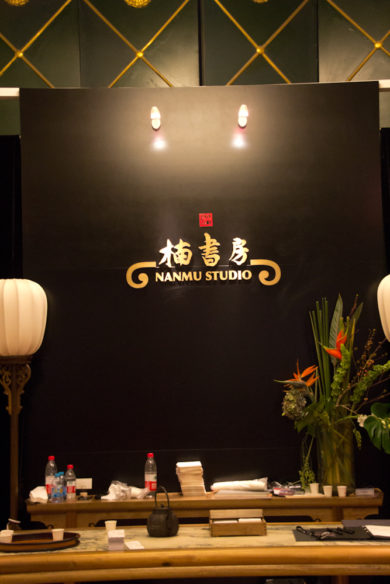
Nanmu Studio creates stunning furniture made of rare wood that can be up to a thousand years old.
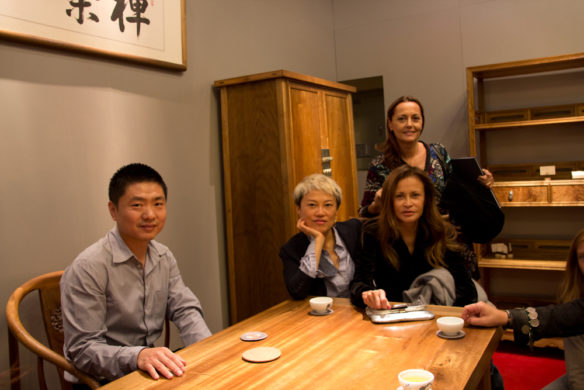
Da Dong Ma, Han Feng, Lizzette Kattan de Pozzi, and Adriana Mannering (standing).

Once polished, nanmu wood takes on a shimmery luster, and doesn’t need lacquer since it’s naturally resistant to warping and decay.
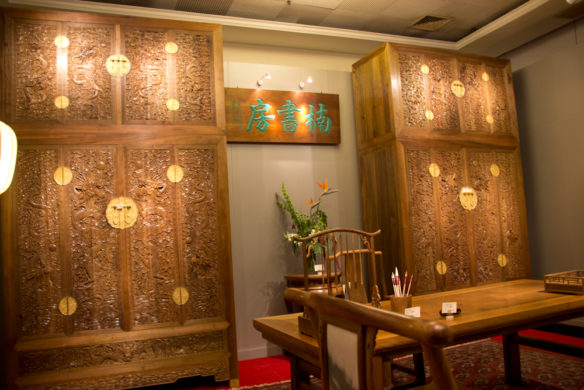
A pair of large cabinets carved with dragon motifs, used by the imperial families.

A closer view of the intricately carved wood.
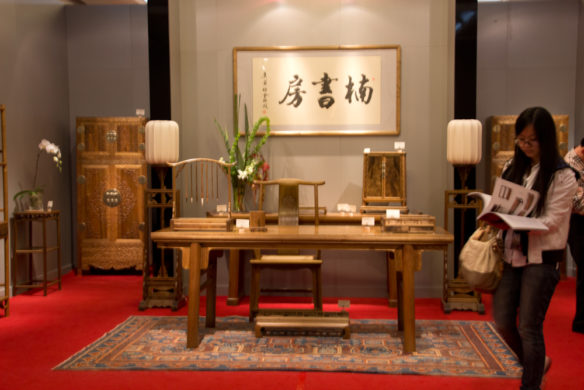
This “scholar’s study” setup displayed the “Four Treasures of the Study,” or wenfang sibao: paper, ink brushes, ink, and ink stone.
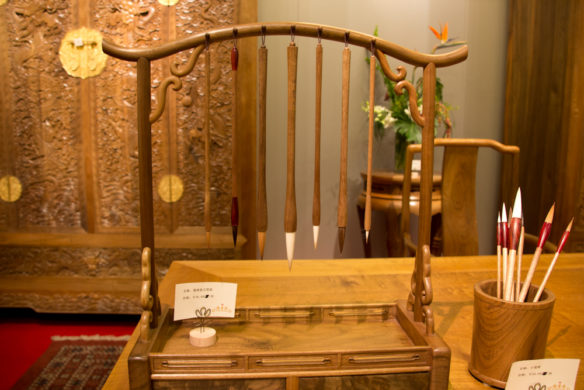
A rack for drying and storing sumi ink brushes sits on the scholar’s desk.
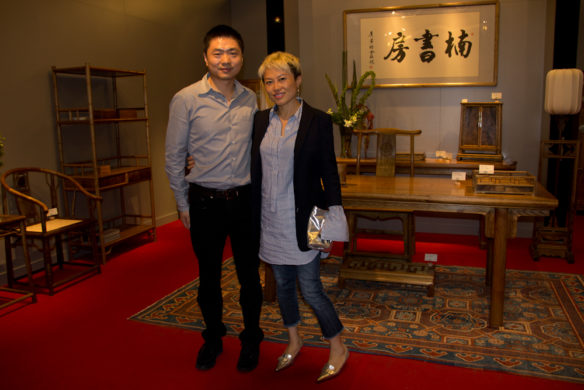
Da Dong Ma and Han Feng.

Because of its rarity, nanmu wood was once used exclusively for imperial furniture and architecture in China.

We loved this Chinese canopy bed with a double moon design and an intricate geometric pattern that actually looked quite modern.
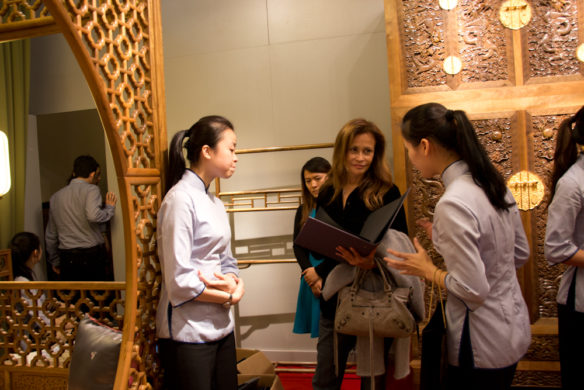
The former fashion editor of Harper’s, Lizzette Kattan de Pozzi asks for the price. We all wanted this bed for ourselves—until we found out how expensive it was!
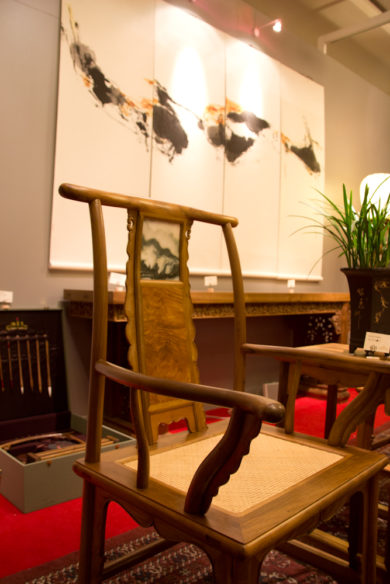
The Ming design is so classic, and features such clean, elegant lines, that it can fit into any décor today.
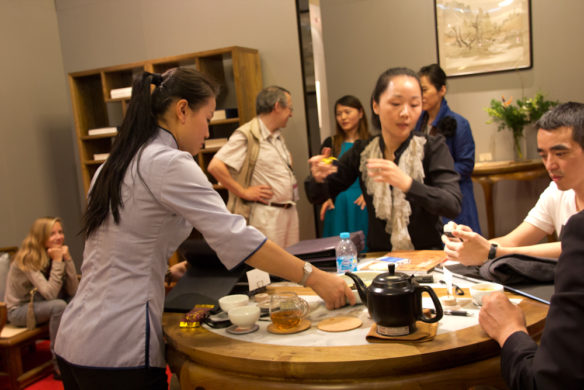
As is the custom, we were invited to sip some green tea before we left.
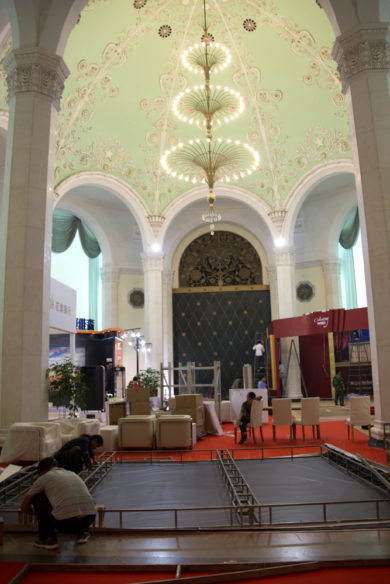
Since we had arrived late on the last day of the exhibition, some displays were already being broken down when we left, but the room with the sea green ceiling was still stunning.

You can see from other grand architectural features of the Shanghai Exhibition Center why it’s in demand for luxury shows.
Photographs by Jeanne Lawrence.
*Urbanite Jeanne Lawrence reports on lifestyle and travel from her homes in San Francisco, Shanghai, and New York, and wherever else she finds a good story.
